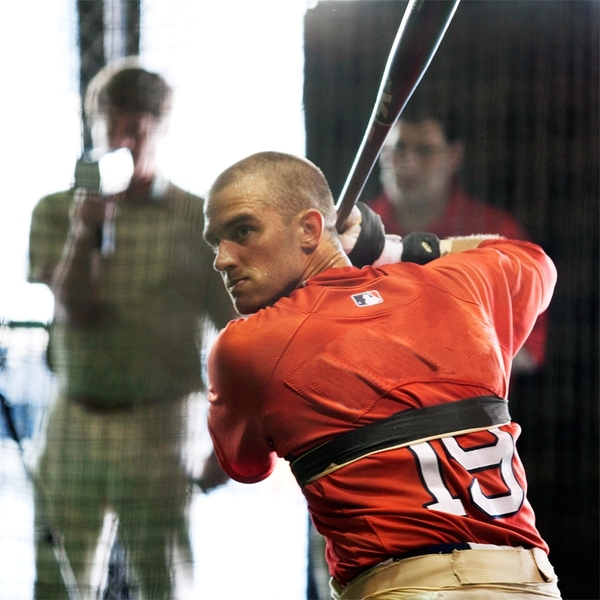On Wednesday, the Boston Red Sox reached Major League Baseball's postseason playoffs for the sixth time in seven years. But whether or not they go on to win another World Series, when the Sox report to spring training next year, they could be spending some time in the trainer's room with members of the MIT Media Lab.
For three of the last four years, Professor Joseph Paradiso and other members of the lab's Responsive Environments Group have been strapping sensors on players at the Red Sox preseason camp to gauge the physical forces they exert when they swing a bat or throw a ball. So far, the researchers have been working mainly with minor-league players, trying to determine what kind of useful information they can extract from the sensors. But next spring, Paradiso hopes to gather more data on more players engaged in a wider range of activities.
If trainers could wire up a hitter when he's on a hot streak, and then again when he's in a slump, they might be able to determine how the mechanics of his swing have changed and how he can fix them. "There's many areas where this technique will have a meaningful influence on how things are perceived and how data is interpreted," says Eric Berkson, one of the Sox' team physicians. As a doctor, Berkson is particularly interested in how the technology could be used to identify behaviors that can lead to injury. "And then, using the same technology, we can try to find better ways to figure out when someone's able to come back from an injury and make sure they don't injure themselves in that process," he says.
The Responsive Environments Group's work with the Sox grew out of a project to allow dancers' movements to control the music accompanying them — "a very Media Lab thing," Paradiso says. While exploring the work's implications for gait analysis with collaborators at Massachusetts General Hospital, Paradiso met some physicians who worked with the Red Sox and were intrigued by the technology. Paradiso and his graduate student Michael Lapinski did the initial work on sensors customized for baseball players, and they've recently been joined by Clemens Satzger of the Technical University of Munich, who's at MIT until January.
Baseball teams had been trying to collect data on the biomechanics of players' swings and pitching motions for years, but they'd relied on optical systems that worked only in the lab and produced data that could be difficult to analyze. "Trying to measure pitching with just an accelerometer has never been done effectively before," says Berkson. "The idea that we can potentially do this biomechanics evaluation during real activities is a huge step."
In fact, the MIT team's sensors use more than just an accelerometer; they also use gyroscopes, and recent versions include a magnetometer that measures joint angles. But the biggest difficulty in developing the sensor, Paradiso says, is that no single accelerometer can handle the range of accelerations — measured as multiples of earth's gravity, or Gs — that a professional athlete can produce during a routine motion. The same goes for gyros and angular acceleration. "For dancers — even though they're pretty kinetic, too — the 10-G range was okay," says Paradiso. "But for athletes — especially for pitchers — you have to go up to 120, 130 Gs to get that full range of motion, and for angular rate, you have to go up to about 10,000 degrees per second." The beginning of a pitcher's windup, however, though no less crucial to his delivery, is so slow that it won't register very clearly on a high-G accelerometer or high-rate gyro. So each Media Lab sensor includes two sets of three-axis accelerometers and gyros that span different ranges, to capture an athlete's full range of activity.
In the hope of further reducing the size of the sensors, Paradiso is talking with a Boston-area device manufacturer about developing accelerometers and gyros that can handle a wide range of accelerations and angular rates, avoiding the need for dual sets of devices. But in the near term, a greater concern is developing ways to get the sensors on and off athletes more efficiently. "In spring training, even with a minor-league player, they're so tightly scheduled, that if you've got 20 minutes with this player, and you take a half-hour, that's going to throw their day off," Paradiso says. The lab is currently experimenting with a new method for mounting the sensors that should be more efficient but will also provide an attachment secure enough to withstand huge accelerations.
Ultimately, Paradiso believes, his group's work with the Sox will aid in the development of commercial devices for measuring biomechanics. Berkson finds that prospect exciting. "We can now look at what's causing injury in a shoulder through a pitcher's real activity, in real-world situations," he says, "and this will help us understand why kids get injured, and why Little League pitching is dangerous for some kids, and why there's an increased number of surgeries happening on these kids on a yearly basis." To some people outside New England, that could sound like an even more important application than helping the Sox to another World Series victory.
Slumping sluggers could soon get help from MIT Media Lab researchers.
Publication Date:

Caption:
A player at the Boston Red Sox preseason training camp is wired with sensors developed by the MIT Media Lab, which gauge the forces he exerts when he swings the bat.
Credits:
Photos: Joseph Paradiso and Alexander Reben

Caption:
A player at the Boston Red Sox preseason training camp is wired with sensors developed by the MIT Media Lab, which gauge the forces he exerts when he swings the bat.
Credits:
Photos: Joseph Paradiso and Alexander Reben





